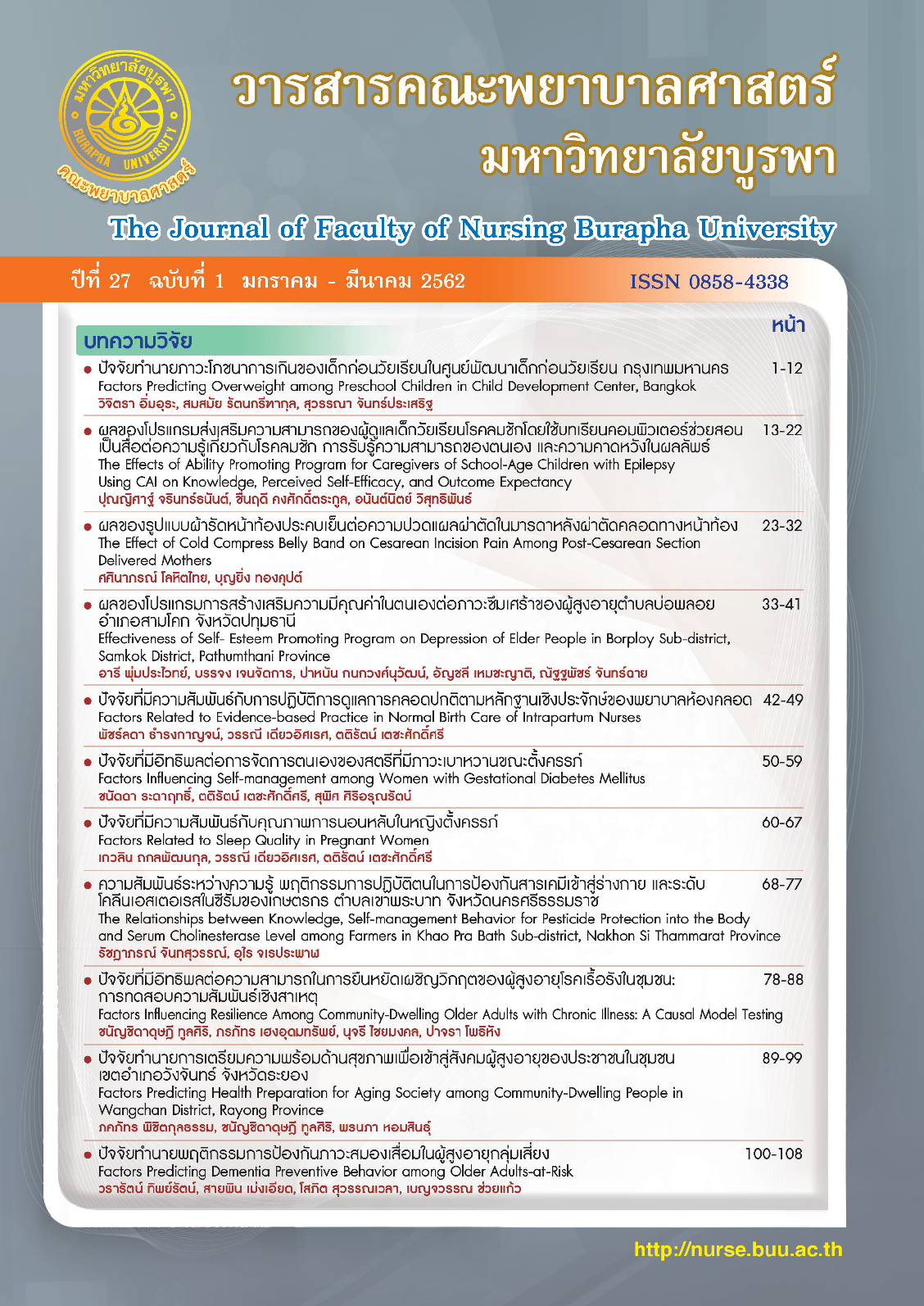ปัจจัยทำนายภาวะโภชนาการเกินของเด็กก่อนวัยเรียนในศูนย์พัฒนาเด็กก่อนวัยเรียน กรุงเทพมหานคร
คำสำคัญ:
ภาวะโภชนาการเกิน, เด็กก่อนวัยเรียน, พฤติกรรมสุขภาพ, ศูนย์พัฒนาเด็กเล็ก, การปฏิบัติแบบพหุระดับบทคัดย่อ
บทคัดย่อ
การวิจัยครั้งนี้มีวัตถุประสงค์เพื่อศึกษาปัจจัยที่มีความสัมพันธ์และทำนายภาวะโภชนาการเกินของเด็กก่อนวัยเรียน กลุ่มตัวอย่างคัดเลือกโดยวิธีการสุ่มแบบหลายขั้นตอน คือ มารดาและเด็กก่อนวัยเรียนอายุ
3-5 ปี ที่เข้ารับบริการในศูนย์พัฒนาเด็กก่อนวัยเรียนของกรุงเทพมหานคร จำนวน 445 คู่ และครูประจำชั้น จำนวน 7 คน เครื่องมือวิจัยเป็นชนิดให้กลุ่มตัวอย่างเป็นผู้ตอบเอง ได้แก่ แบบสอบถามพฤติกรรมของเด็ก ความรู้และพฤติกรรมของมารดา สิ่งแวดล้อมที่บ้าน สิ่งแวดล้อมในศูนย์พัฒนาเด็ก และแบบบันทึกข้อมูลทั่วไป วิเคราะห์ข้อมูลโดยใช้สถิติพรรณนา และสถิติการถดถอยโลจิสติก
ผลการวิจัยพบว่า ภาวะโภชนาเกินของเด็กก่อนวัยเรียนในศูนย์ฯ มีอัตราเฉลี่ยร้อยละ 11.9 ปัจจัยที่มีสามารถทำนายภาวะโภชนาการเกินของเด็กก่อนวัยเรียนอย่างมีนัยสำคัญทางสถิติ ได้แก่ การบริโภคอาหารของเด็ก (OR = 10.27, 95%CI = 3.60 - 29.32) การเคลื่อนไหวร่างกายของเด็ก (OR = 4.30, 95%CI = 1.63 - 11.34) ความรู้ของมารดา (OR = 3.19, 95%CI = 1.16 - 8.80) การจัดอาหารของมารดา (OR = 5.63, 95%CI = 2.19 - 14.52) อาหารที่จัดเก็บในบ้าน (OR = 9.57, 95%CI = 3.06 - 29.90) พื้นที่ทำกิจกรรมที่บ้าน (OR = 6.28, 95%CI = 2.45 - 16.06) และการจัดอาหารของศูนย์ฯ (OR = 0.21, 95%CI = 0.05 - 0.91) มีอำนาจการทำนายร้อยละ 93 ผลการวิจัยนี้ให้ข้อเสนอแนะว่า พยาบาลและผู้มีหน้าที่ดูแลสุขภาพเด็กที่อยู่ในศูนย์พัฒนาเด็กวัยก่อนเรียนและในชุมชนสามารถนำผลการวิจัยไปใช้เป็นแนวทางพัฒนาโปรแกรมส่งเสริมสุขภาพเพื่อปรับเปลี่ยนพฤติกรรมสุขภาพและป้องกันภาวะโภชนาการเกินให้แก่เด็กก่อนวัยเรียนโดยเน้นให้มีการปฏิบัติแบบพหุระดับ
เอกสารอ้างอิง
Aino, S. (2016). School environmental factors affecting overweight rate of kindergartener in Bangkok. Master of Nursing Science, Community Nurse Practitioner, Faculty of Nursing, Burapha University. [In Thai]
Burmeister, A. E., Hoffmann, D. A., Meers, M. R., Koball, A. M., & Eizenman, D. R. (2014). Food consumption by young children: A function of parental feeding goals and practices. Appetite, 74, 6-11.
Campbell, K. J., Crawford, D. A., Salmon, J., Carver, A., Garnett, S. P., & Baur, L. A. (2007). Associations between the home food environment and obesity-promoting eating behaviors in adolescence. Obesity, 15(3), 719-730.
Chivanon, N. (2016). Accidents in children: Situation and prevention. The Journal of Faculty of Nursing, Burapha University, 24(3), 1-12. [In Thai]
Davison, K., & Birch, L.L. (2001). Childhood overweight: A contextual model and recommendations for future research. Obesity Review, 2(3), 159-171.
Hsieh, F. Y. (1989). Sample size tables for logistic regression. Statistic In Medicine, 8, 795-802.
Quality Learning Foundation. (2014). Early childhood development. Retrieved from http://seminar.qlf.or.th/File/DownloadFile/616.Early childhood development. [In Thai]
Ministry of Public Health. (1999). Guidelines for using weight reference criteria to evaluate
the growth of Thai children. Bangkok: Ministry of public health. [In Thai]
Ministry of Public Health. (2013). Standard Guide to Child Center. Bangkok: Bureau of health promotion, Department of health. [In Thai]
Ministry of Public Health. (2014). Eat by the age. Bangkok: Ministry of public health. [In Thai]
Mosuwan, L. (2013). How to care obese children. Retrieved from http://nutrition.anamai. moph.go.th/ewt_news.php?nid=114 [In Thai]
Nantapong, S., Saratapun, N., & Hirunwong, A. (2014). Parents’ knowledge on nutrition and meal-providing behavior for preschool children at a public school in Chumphon province. Kasetsart Journal: Social Sciences, 35, 235-244. [In Thai]
National Statistical Office. (2013). The multiple indicator cluster survey (MICS) of child and
women in Thailand 2012. June 8, 2016. Retrieved from https://www.unicef.org/thailand/57-05-010-MICS_TH.pdf [In Thai]
Panyarattanachoj, J., Toonsiri, C., & Rattanagreethakul, S. (2017) Factors preventive behaviors for overweight among primary school students in Samut Songkhram municipality school. The Journal of Faculty of Nursing, Burapha University, 25(2), 43-56. [In Thai]
Puder, J. J., & Munsch, S. (2010). Psychological correlates of childhood obesity. International Journal of Obesity (Lond), 34(2), 37-43.
Social Development Department. (2016). Statistics of Bangkok's pre-school development center. March 18, 2016. Retrieved from http://www. bangkok.go.th/social/page/ sub/8101 [In Thai]
Society of Pediatric Nutrition of Thailand, & The Royal College Pediatricians of Thailand.
(2014). Guidelines for the prevention and treatment of childhood obesity 2014. Retrieved from http://www.thaipediatrics.org/Media/media-20161208151655.pdf [In Thai]
Van, C. E., De, B. I., Maes, L., & Cardon, G. (2012). Efficacy and feasibility of lowering playground density to promote physical activity and to discourage sedentary time during recess at preschool: A pilot study. Preventive Medicine, 55(4), 319-321.
World Health Organization. (2014). World health statistic 2014. January 2, 2016. Retrieved from http://apps.who.int/iris/bitstream/10665 /112738/1/ 9789240692671_eng.pdf
Yuenyong, S., Moopayak, K., & Suwonaroop, N. (2012). A Comparative study of factors related to the nutritional status of preschool children in Muang District, Suphanburi Province, Thailand. Journal of Nursing Science, 30(2), 90-100. [In Thai]





